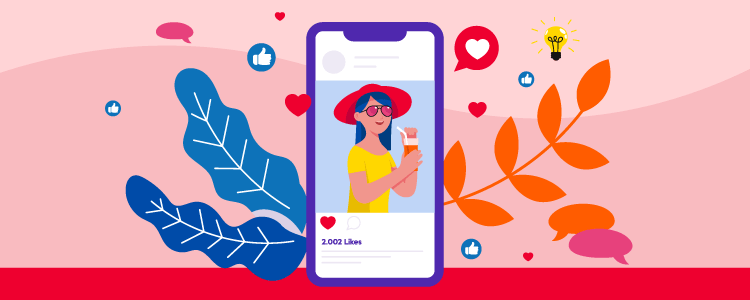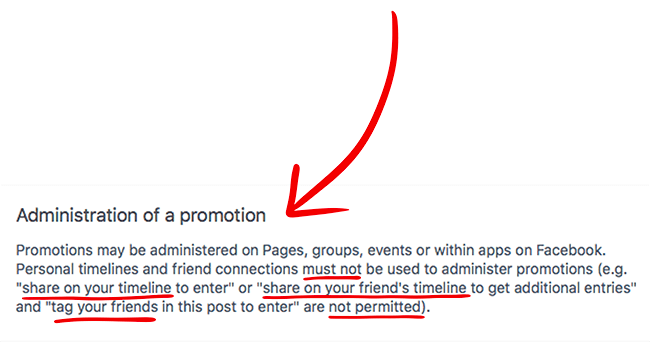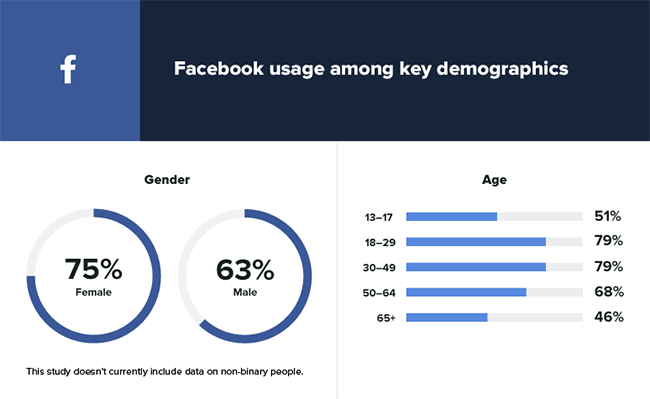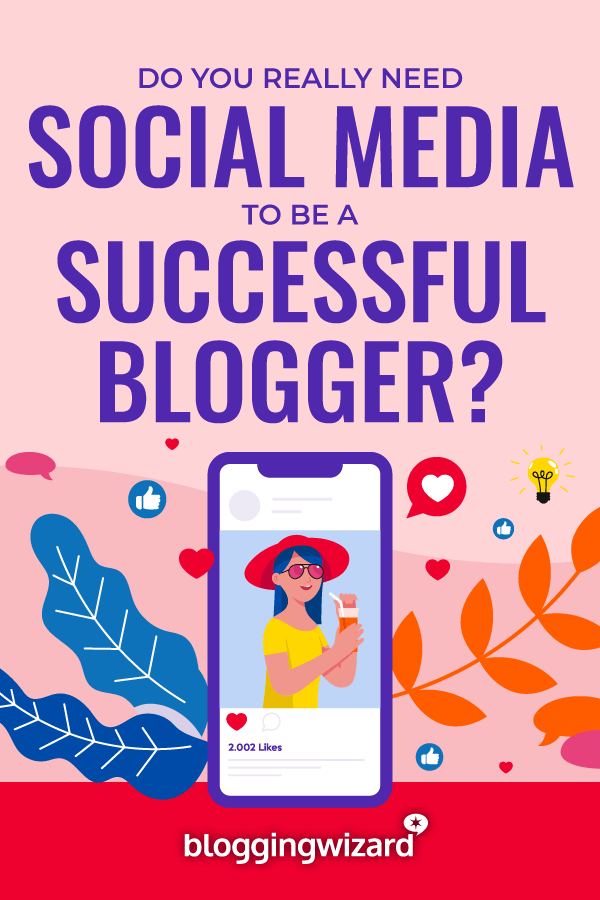Do You Really Need Social Media To Be A Successful Blogger?

Hi, my name is Kim, and I like to make bold statements online. Just like this one, which is bound to throw a cat amongst the proverbial pigeons …
You DO NOT need social media to be a successful blogger.
”I hope you’ve got the facts to back that up!” I hear you cry.
Don’t worry, I totally have. My opinions on this matter have been forged over almost a decade of blogging and content-creating; they’re based on a lot of observations and experiments. Social media is great for promotion and marketing, but it’s not essential that you learn the ins and outs of every platform to make it ‘big’ in the blogging world.
Far from it.
And actually, I know quite a few high-earning, big-traffic site owners who’d agreed with me.
But I know that you need evidence and some sort of explanation for my shocking social media statement — and that’s just what I’m about to give you …
Exhibit A: You’re promoting to your competition.
Unless you have more than a few thousand followers, there’s a pretty good chance that the people in your little social media community are people just like you — your competition. If you’re a beauty blogger, you follow other beauty bloggers, right? And if you’re a writer, you follow other writers. You’re TOLD to do this by experts.
“Follow and engage with those in your community to grow your account!”
The whole point of doing all of that is to make yourself look popular, appeal to the algorithm overlords, and hopefully reach the non-community beyond. If you’re stuck, stale, stagnant, not growing, you’re simply promoting your stuff to your competition over and over again.
(*I mean ‘competition’ in a general way, #communityovercompetition and all that.)
Guess who’s probably not going to click on your affiliate links and buy your blogging products, or even read your blog posts?
People with affiliate links and blog stuff of their own to peddle, that’s who!
A little back story:
I used to have a review website that got 99% of its traffic from search engines. Facebook worked to drive traffic to it occasionally, but Instagram and Twitter? Nope. I personally found them useless for that particular niche.
All of my engagement was coming from other people running competing blogs, and they might’ve been sharing/retweeting/liking/commenting on my tweets or Insta-updates, but they weren’t ever clicking through to read my blog posts. Nor were they purchasing items through my affiliate links.
I was wasting hours of my time each month promoting to people on Twitter and Instagram who’d received the same items, in the same PR packages, from the same companies.
People who found my blog and reviews through Google, however, WERE reading my blog posts and clicking on my affiliate links and making purchases. Optimising the site for search engines rather than pumping out social media promotion was a much more productive and profitable use of my time.
This actually brings me nicely to my next point …
Exhibit B: You’re wasting your time. (Maybe.)
I once spent 25 hours over 3 days creating Instagram content for a beauty blog — images/videos/slides/stories, writing witty captions, researching hashtags, scheduling at the ‘right’ times to post (according to Insights), etc. — in a bid to overhaul my failing Instagram strategy.
I ‘liked’ and commented on other people’s Insta-updates before I posted my own, actively engaged with my community, followed a bunch of new accounts (and didn’t unfollow them), and responded to people who engaged with me.
The account started with fewer than 1,000 followers. After posting new content 30 times over 19 days – and all of the engagement steps above – I lost more followers than I gained, barely managed to get more than 10 (YES, TEN) likes on a single post, and absolutely NOBODY clicked on the #linkinbio to view my actual site. I felt so disheartened that I wanted to throw my whole phone out of the window.
So, when the time came to create a new batch of Instagram content, I didn’t. I spent that time (approx. 25 hours) on creating a couple of new, evergreen, fully-SEO’d blog posts and designing multiple Pinterest Pins for them instead. One of those Pinterest Pins went viral almost immediately, the post went on to become the most-viewed on my blog, and it went on to rank #2 on Google for the targeted keyword.
What’s my point?
At some point, if a platform doesn’t work for you despite all of your best efforts, it’s wise to stop wasting time on it and move on to something else.
If I’d wasted my time on creating a second batch of Instagram content rather than focusing on creating new search engine optimised blog posts and Pinterest Pins, I’d never have had that viral pin, nor would I have had that high-ranking blog post that is STILL one of the top 3 posts for that blog in terms of traffic.
Take a moment to evaluate your current position, especially if you’re a new (ish) blogger. What’s working? What isn’t? If you only have a limited amount of time or resources, don’t spread yourself thin by trying to master all of the different platforms. If you do, you’ll pump out half-hearted work, completed in half the time, with very little thought gone into it.
You DO NOT need to use every single social media platform there is to promote yourself or your blog/business. By attempting to, you could be wasting your own time.
Exhibit C: Social media platforms go down.
And what happens when they do? If Instagram is your number one source of traffic, Instagram going down means that your blog also technically goes down.
If you had focused your attention on search engine optimisation, on the other hand, it wouldn’t matter too much if Instagram went down for a couple of hours; you’d still get traffic referred to you from Google and other search engines.
Social media platforms don’t just go down either; they also change in popularity. Once upon a time, Facebook was the word on everyone’s lips. A little while back, every single blogger out there was raving about how much Pinterest had changed their blogging strategy.
Right now, TikTok is racking up those numbers. In quarter 4 of 2019, TikTok was the second most downloaded mobile app, beating Facebook and Instagram. [12 TikTok Statistics That’ll Help You Master The Social Platform.]
But let’s take TikTok as an example: it’s new … and it appears to be a little problematic. From allegedly oppressing content from certain groups of people to apparently muting entire world-trending hashtags, TikTok has seen its fair share of bad press over recent months. And with the threat of a US ban on TikTok looming because of reported data privacy problems and other cyber risks, it would definitely appear to be the WRONG time to put all of your proverbial eggs into that basket.
I’m not saying that you should abandon your TikTok strategy … but it’s probably a good time to implement some kind of backup plan, just in case. If TikTok – or any other social media platform – suddenly disappeared forever, and that social media platform was the sole driver of traffic to your blog, what would you fall back on?
SEO is that backup plan. It’s always there. It always works, providing you’ve implemented the correct SEO techniques, and it always drives traffic to your blog, no matter what’s happening to Twitter, Instagram, TikTok, or any other platform.
SEO’ing a blog post is actually a lot easier than people would lead you to believe, too. Take a peek at this guide and play around with an old blog post to get your bearings, and we bet you’ll pick the steps up and see results in just a few weeks: What Is SEO? A Beginner’s Guide To Search Engine Optimization.
Exhibit D: Social media accounts get deleted or suspended.
A couple of years ago, one of my websites was marked as spam by Pinterest. Whenever someone clicked on my Pins, a notice would come up alerting people that my website was spam and not to be trusted. I appealed the decision (because I wasn’t spam) and they reinstated my account, with an email apology for my inconvenience.
The story ends well, but not everyone who appeals social media suspension decisions gets the suspension overturned. In fact, I can probably provide you with more evidence of appeals going completely unanswered than I can of them being successful.
On a slightly related note, are you aware that your #FollowFriday threads on Twitter are technically classed as “reciprocal inflation” and are actually a violation of Twitter’s platform manipulation and spam policy?

And how about the rules for running competitions on sites like Facebook and Instagram? Do you know the rules – specifically, what you can and can’t ask people to do – for running competitions on those platforms?

A lot of us partake in policy-violating actions on social media every day, without realising. The guidelines and policies of these platforms are very boring to read, yes … but they’re also important to read. Twitter is one of those platforms that has a habit of suspending or deleting accounts with reckless abandon, and for seemingly no reason at all. But a lot of the time, those ‘unknown’ punishments are because of minor violations that people don’t even realise are violations.
Growing your account by engaging with the community, using follow-for-follow or comment-for-comment-style threads, is encouraged by experts … but it’s also practice that could see your account suspended, or worse: permanently deactivated and deleted.
What will you do when your number one traffic driver, with many thousands of followers, is permanently punished for a minor follow-for-follow violation?
I’ll say it again: SEO is your backup plan.
Losing 10K Twitter followers in one fell swoop is going to be a lot easier to stomach when you’ve still got traffic being directed to your blog from search engines.
Exhibit E: Not every social media platform is going to work for you.
And what I mean by that is, not every social media platform is going to appeal to YOUR target audience.
84% of 25-30 year old American adults use Facebook, according to Sprout Social.

But if you look at the same age group – 25 to 30 year old US adults – on different social media platforms, you’ll see that things change quite dramatically.
Only 28% of 25-30 year old American adults use Pinterest.
47% of the same age group uses Snapchat.
94% of the same age group uses YouTube.
31% of the same age group uses Twitter.
57% of the same age group uses Instagram.
If you were specifically targeting a 25-30 year old audience, the best social media platform to use would be YouTube (94%), followed by Facebook (84%), Instagram (57%), Snapchat (47%) and then Twitter/Pinterest.
If you focus all of your attention on Twitter, you’re technically only ever reaching 31% of your target demographic.
It would be a wise move to find out the most popular platform(s) for your particular audience and consider whether you have the ability to focus more of your attention and time there. Ask yourself what age range you’re creating content for, alongside gender, location, income, education, etc., and then do a little research. Here are a few fun things I learned by doing exactly that:
YouTube is the most preferred platform for US adults earning less than $30K per year.
More 13-17 year olds use Snapchat than any other age group.
Only 15% of American adult men use Pinterest, compared to 42% of women.
You may find, after doing that research, that you’ve been putting all of your energy into promoting your content to an audience that simply isn’t there.
You’ll probably find these quite helpful:
- 100+ Blogging Statistics That Will Help You Create A Better Content Strategy
- 25 Facebook Statistics That Will Help You Rock Your Social Media Strategy
- 21 Twitter Statistics & Facts To Level Up Your Social Media Strategy
- 21 Instagram Stats And Facts To Grow Your Online Presence
Exhibit F: Sometimes, you just won’t get ‘it’.
I can’t work Snapchat for love nor money. It gives me chronic anxiety every time I open the app because I’m super scared that everyone’s going to see my morning grump face, minus makeup, hair all sticking in random directions. I’ve read all of the guides, tried it out a few times, and made a right mess of things every single time.
I JUST DON’T KNOW HOW TO USE IT!
And do you know what? It’s perfectly okay that I can’t use it.
My mother will never get the hang of Instagram, but she’s a dab hand at Pinterest.
I’ll probably never get the hang of Snapchat, but I’m a dab hand at Pinterest and I also happen to be pretty good at the old SEO stuff, too.
My best friend can’t send a tweet to save her life, but she’s managed to conquer the Facebook world and bizarrely never needs to rely on boosted ads to up her engagement … ? (It’s some kind of sorcery, I think.)
You do not have to use every social media platform — or, indeed, any of them.
If you force yourself to learn and then use a social media platform you despise, you’ll resent it, never use it, and spend more time worrying about using it than actually creating or sharing content. Trust me on this, I know.
There is nothing to stop you from trying again, a few weeks or months later, once you have more time on your hands.
There is also nothing to stop you from ignoring that platform completely and never looking at it again.
Don’t feel pressured into using a social platform you don’t like just because everyone else is telling you to. These bandwagons are fleeting. A year ago, everyone was shouting about Pinterest from the tops of their lungs, but there’s already been a change in the way the platform works, reducing the impact of previously very successful campaigns.
They’re just trends, and they change. You can always jump on the next bandwagon!
To summarise …
I’ve shared a lot of opinions and ideas with you today, but it is ultimately down to you to decide which social media platforms, if any, you’re going to invest your time and energy in.
I recommend trying to come up with a healthy balance of working with the platforms that genuinely work for you, and working with the platforms that you love — but above all else, pay a little bit of attention to SEO’ing your blog and blog posts.
Spending 25 hours on creating Instagram content to get ZERO blog clicks out of it, when you’re using it as a method to promote a blog, is not smart … and that’s especially the case if you’re doing it week after week after week.
Spending that time SEO’ing past blog posts, creating new search engine optimised blog posts, and getting your site to rank higher in Google results, on the other hand, is smart — and it’ll come in mighty handy next time Instagram goes down, or Pinterest marks your website as spam and Twitter decides you belong on the naughty step.
Related Reading: The Best Social Media Management Tools (Comparison).

